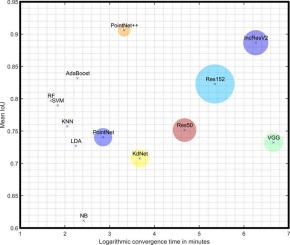ISPRS Journal of Photogrammetry and Remote Sensing ( IF 10.6 ) Pub Date : 2020-08-10 , DOI: 10.1016/j.isprsjprs.2020.08.001 Zhouxin Xi , Chris Hopkinson , Stewart B. Rood , Derek R. Peddle

|
Determining tree species composition in natural forests is essential for effective forest management. Species classification at the individual tree level requires fine-scale traits which can be derived through terrestrial laser scanning (TLS) point clouds. A generalizable species classification framework also needs to decouple seasonal foliage variation from deciduous species, for which wood filtering is applicable. Different machine learning and deep learning models are feasible for wood filtering and species classification. We investigated 13 machine learning and deep learning classifiers for 9 species, and 15 classifiers for filtering wood points from TLS plot scans. Each classifier was evaluated using the criteria of mean Intersection over Union accuracy (mIoU), training stability and time cost. On average, deep learning classifiers outperformed machine learning classifiers by 10% and 5% in terms of wood and species classification mIoU, respectively. PointNet++ provided the best species classifier, with the highest mIoU (0.906), stability, and moderate time cost. Among wood classifiers, UNet achieved the top mIoU (0.839) while ResNet-50 was recommended for rapid trial and error testing. Across the classifications, the factors of input resolution, attributes and features were also analyzed. Hot zones of species classification with PointNet++ were visualized to indicate how AI interpret species traits.
中文翻译:

观看森林和树木:用于地面过滤和树木分类的有效机器和深度学习算法
确定天然林中的树种组成对于有效的森林管理至关重要。在单个树木级别上的物种分类需要精细的特征,这些特征可以通过陆地激光扫描(TLS)点云得出。通用的物种分类框架还需要将季节性的树叶变化与落叶的物种分离开来,对此适用木材过滤。对于木材过滤和物种分类,不同的机器学习和深度学习模型是可行的。我们调查了9种物种的13个机器学习和深度学习分类器,以及15个用于从TLS绘图扫描中过滤木点的分类器。每个分类器均使用平均交会精度(mIoU),训练稳定性和时间成本的标准进行评估。一般,就木材和物种分类mIoU而言,深度学习分类器的性能分别比机器学习分类器高10%和5%。PointNet ++提供了最佳的物种分类器,具有最高的mIoU(0.906),稳定性和适度的时间成本。在木材分类器中,UNet获得了最高的mIoU(0.839),而ResNet-50被推荐用于快速试验和错误测试。在所有分类中,还分析了输入分辨率,属性和特征的因素。使用PointNet ++对物种分类的热点区域进行可视化,以指示AI如何解释物种特征。UNet获得了最高的mIoU(0.839),而ResNet-50被推荐用于快速试验和错误测试。在所有分类中,还分析了输入分辨率,属性和特征的因素。使用PointNet ++对物种分类的热点区域进行了可视化,以指示AI如何解释物种特征。UNet获得了最高的mIoU(0.839),而ResNet-50被推荐用于快速试验和错误测试。在所有分类中,还分析了输入分辨率,属性和特征的因素。使用PointNet ++对物种分类的热点区域进行可视化,以指示AI如何解释物种特征。











































 京公网安备 11010802027423号
京公网安备 11010802027423号